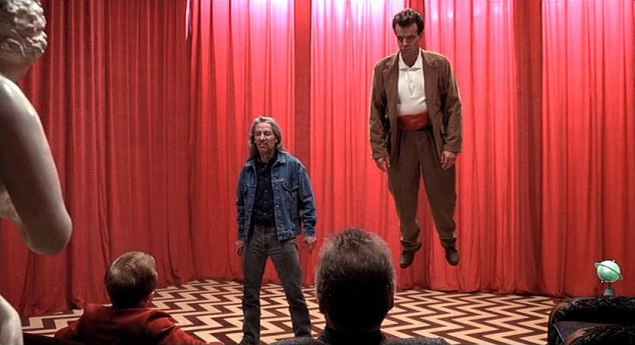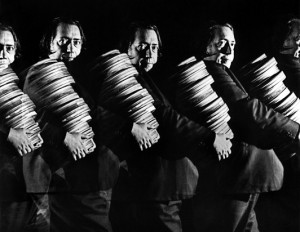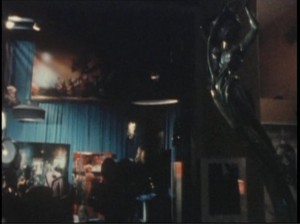Considering they’re both serial TV dramas, Twin Peaks and the Wire couldn’t have much less in common. Twin Peaks explores the quirky surrealism of a small town; the Wire looks at the intricate realism of a city. Creator David Lynch uses the improvisational rhythm of dreams; creator David Simon relies on the layered narrative of investigative reporting. And where the Wire is one of the most multi-racial shows ever to appear on television, Twin Peaks is, insistently, not.
Yet, on closer inspection, the two shows had in common. In particular, both Twin Peaks and the Wire are obsessed with the real.
In part, this obsession is a function of genre. For all their differences, both shows are at heart police shows, and both are built around investigations and the ferreting out of secrets. In both, the techniques and expertise of the protagonists are leant to the viewer, who is enabled to approach nearer and nearer to a provocatively concealed heart of corruption. The famous scene in the Wire, where McNulty and Bunk deduce how a murder was committed while communicating solely by using the word “fuck” is analogous, in its flamboyant hermeticism, to the scene in Twin Peaks where Dale Cooper identifies likely suspects by referencing Tibet and throwing stones at bottles.
Whether through a triumph of earthy procedure or through semi-mystical intuition, the results are the same — the knowing expert shines light into the heart of darkness.
“Heart of darkness” has racial connotations of course — and that’s apropos for both shows. The connection between race and reality is most obvious in the Wire, a show immersed in the vibrancy, and despair of Baltimore’s African-American community. Omar’s transcendent cool, Kima’s understated integrity, D’angelo’s tragedy, and Snoop’s brutality are all manifestations of intertwined authenticity and blackness. The white characters, too, draw their grit in large part from the show’s integration. Thus Entertainment Weekly praises McNulty for his funk, which it links to his “easy rapport with his African-American work partners.”
Race at first appears to be almost entirely absent from Twin Peaks…but the absence speaks loudly. The show is set in the perfect American small town, with people who are all friendly, all decent, all blessed with movie star good looks, and, oh yes, (with the exception of a stereotypically untrustworthy Asian woman and a stereotypically spiritual Native American) virtually all white.
That whiteness — the trusting small town, the blonde homecoming queen cheerleader — is part and parcel of the perfection. And as the town’s secrets are revealed, it is not just the perfection, but the whiteness, which is shown to be a facade above a swirling pit of jealousy, greed, and deformation. Laura Palmer, that blonde homecoming queen, is addicted to cocaine just like all those black junkies on the Wire. Her father, Leland, is, in the depths of his twisted soul, not white at all, but rather the demonic spirit BOB played by Native American actor Frank Silva.
Moreover, the whiteness in Twin Peaks is undercut and doubled by its own queerness. The show is an extended meditation on the campiness of whiteness; the perfect exterior concealing melodrama and lust. When Laura’s best friend Donna wears her friend’s sunglasses, she turns into a teen femme fatale, exterior transforming interior. More pointedly, after Laura’s death, her murderer/rapist father, Leland, begins to compulsively dance to show tunes, his dark sexual secret finding expression through his response to stereotypically gay cultural responsiveness.
The truth in Twin Peaks is ultimately Freudian; the revelation of the ogre father and the primal scene. In the prequel, Fire Walk With Me, we learn that Leland has been raping her daughter since she was 12; in the series itself, another father almost sleeps with his daughter. In The Wire, on the other hand, the revelations are less psychological and more pragmatic, focusing on the overwhelming, crushing, and corrupting power of institutions.
There are many other cop shows built around investigation, of course. But where something like Bones or the Mentalist lets the knowing detective tie up the truth in a pretty bow at the end of (at least most) episodes, the Wire and Twin Peaks treat truth as an overwhelming excess, which expertise can provisionally master but not contain. The resulting tragedy is is in many ways the guarantor of the reality. The real does not have a happy ending. The Wire concludes by establishing that life in Baltimore will go on as before; while some individual characters may escape to provisionally bright futures, the city as a whole is no closer to escaping its pathologies than it was at the beginning of the series. Twin Peaks effectively ends with the death of Leland and the escape of BOB. The culprit is dead, but his spirit lives on…and to the extent that the series abandoned that grim insight in its later part, it became virtually unwatchable (or, at least, I couldn’t watch it.)
I love both Twin Peaks and The Wire. I think they both deserve their reputations as the greatest television show ever. I do wonder though how much that reputation is about their mutual obsessions with the real. Television has often been seen as uniquely irrelevant bone-headed escapism. The Wire and Twin Peaks both, in quite different ways, present themselves as windows onto unpleasant truths. They’re serious because they show us what is, and provide no escape. Laura’s ascent to heaven in Fire Walk With Me seems more a dream to emphasize the tragedy than an actual cause for optimism, while McNulty’s final attainment of peace seems like an instance of accepting what he can’t change rather than a broader assertion of hope. Evil is fixed; experts know but can’t save us, or even themselves. It’s a grim vision so critically embraced that one starts to wonder if it could be, at times, self-fulfilling.
_________________
Coincidentally, I just watched Tarkovsky’s film Stalker, which has a very different take on the real. Stalker is ostensibly a science fiction tale set in the Zone, a mysterious, dangerous realm where your deepest wish may be granted. Tarkovsky, though, makes no use of special effects of any kind, and so the Zone appears as simply any other piece of countryside. The three men wandering through it, casting nervous glances this way and that, seem like children playing a not-very-convincing game of make-believe — a sensation only emphasized by Tarkovsky’s long takes and excruciatingly slow pacing. The camera frames a long shot of a field, the men in the distance move across it…and still move across it…and still move across it…giving your attention a chance to wander to the trees, and the sky, and then back and yep, the men are still crossing the field…and you’ve got plenty of time to think about how silly the actors must have felt, and wonder whether they were thinking about their motivation, or how silly the script is, or just about whether they were ever going to get to stop walking across the field and go to the bathroom, for the love of God.
Eventually the guide (Stalker) leads his two followers (Writer and Professor) to the wish-granting center of the Zone, called the Room. But at the last minute both of the followers, perhaps fed up with the transparently ersatz nature of the whole endeavor, refuse to participate in the silliness anymore and balk at going in. One of the film’s last scenes shows Stalker back in his beautifully grungy hovel, lying down into his bed as if reclining in an Old Master painting, bewailing the intelligentia’s lack of faith. “Can people like that believe in anything!” he moans. “And nobody believes! Not just those two. Nobody!” After comforting him, his long-suffering wife breaks the fourth wall and directly addresses the camera, insisting that despite all her troubles, she has never regretted her life with the Stalker. “It’s better to have a bitter happiness” she says, “than a gray, dull life.”
On the one hand, Stalker is like the Wire; it fetishizes grit. The first part of the film, before the protagonists make it into The Zone, is set in an urban landscape which is run down even by the standards of the Wire’s Baltimore. On the other hand, Stalker shares characteristics with Twin Peaks. Both fetishize a secret, dangerous realm just out of sight.
But where the Wire and Twin Peaks figure the physical and spiritual as truths for genre to reveal, in Stalker both function more as consciously framed tropes. The Stalker’s hovel is so ravishingly shot and carefully composed that it becomes a quotation about grit rather than a direct apprehension of it. The intimations of otherworldliness in the Zone are so stubbornly unrealized that they become quotations about surrealism rather than an actual apprehension of subterranean dangers.
Stalker loves these genre references, but not because they show reality. Rather, it loves them as genre — as the imaginary. And if there’s a real in Stalker, it’s not in these pulp gestures, but in the process of film itself; the shots of grassland or a wall or a face held so long that narrative drains away, and you’re left looking at grassland or a wall or a face. The real is not the end result of a process of meaning, but the beginning of a process in which meaning must be added. The wall can be poverty; the grassland can be an ominous psychological truth; but the viewer must make it so. Art does not strip away to an essence, but adds to a blank. The Wire is worthwhile not because it is true to Simon’s Baltimore experience, but because of the energy of its narrative entanglements; the energetic metaphoricity of D’Angelo at the chess board or the profaner-than-life dreamed-of universal signification of “fuck”. Twin Peaks is profound not because it shows the real corruption of small town America, but because of its hollow flamboyance, haunted by specters of irony and dread. The shows are great not because they’re real, but because they’re imagined.
The very last scene of Tarkovsky’s film shows the Stalker’s crippled child sitting at a table, staring at glasses, and apparently moving them (slowwwwly) with her mind. After she stops, we hear a train pass, and the glasses shake. The telekinesis is, of course, just a special effect…and it emphasizes the fact that the train shaking the house is probably a special effect too. Tarkovsky seems to be almost taunting us, daring us to accept the shaking but not the telekinesis — or rather, to accept both. For Stalker, film is not about gaining expertise and seeking truth. It’s a way to practice faith.





